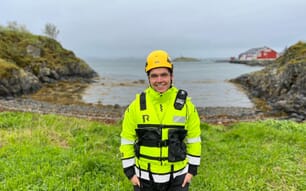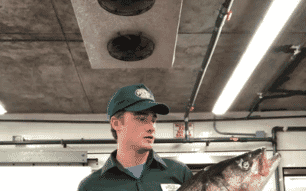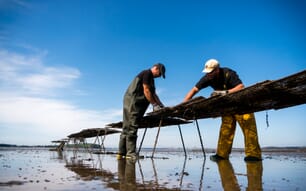
© Ryan Marchington
Marchington may be early in his career – at just 27 – but as aquaculture science and operations lead at Greenwave Aotearoa, he’s at the forefront of one of the ocean’s most sustainable farming frontiers.
Seaweed ocean farming, he explains, requires no feed or fertilisers, creates marine habitats and can provide a new income stream for coastal communities. And if he had to pick a favourite species? Without hesitation: Macrocystis pyrifera – the giant kelp found in cool waters off places like New Zealand, California, South Africa and Chile.
“It has these big pneumatocysts [the gas-filled sacs that keep the blades buoyant] that make the kelp flow and appear like a forest. It is an underwater forest and it symbolises what kelp farming could be and the habitats it could create. It’s the true king of kelp,” he says.
From Manchester to New Zealand
Growing up in landlocked Manchester, Marchington first encountered the sea during family holidays in Wales, where he fished, crabbed, surfed and dived. A passion for marine life led him to study marine biology at Newcastle University, where a lecturer opened his eyes to the potential of algae.
After early experience on a spirulina farm in Portugal, he pursued a master’s in sustainable aquaculture at the University of Plymouth, then a research placement at the Institute of Marine Research in Vigo, part of Spain’s National Research Council. He worked on a project that explored the use of Ulva in recirculating aquaculture systems (RAS) alongside finfish to reduce pathogens and improve water quality.
Breaking into the sector wasn’t easy in 2021, when the “seaweed boom” had yet to fully take off, but eventually he secured a position at the Scottish Association for Marine Science (SAMS).
“I was working at the Culture Collection of Algae and Protozoa. It was great experience, but I wanted to be outside and involved more in more applied work,” he recalls.
He soon moved into a new role leading SAMS’s Seaweed Nursery, supplying kelp to farmers across the UK, Greenland and Norway. That position gave him the fieldwork and international exposure he was after.
Marchington notes that the seaweed industry in the Western world, which he feels was a bit late to the party compared to other regions, is now accelerating. Over a year ago, Marchington approached EnviroStrat seeking opportunities in New Zealand aquaculture and seized the chance to take on the responsibility for driving the seaweed aquaculture operations for Greenwave Aotearoa.
“I love being outside, being on the water. And now I get to collaborate with companies and researchers all over the world. In the past year alone, we have worked closely with companies and universities in the USA, French Polynesia, Europe, Australia and here in New Zealand. I’ve had the chance to work with lots of different cultures, including closely with Māori communities in New Zealand. It’s fascinating to see how seaweed is valued in different parts of the world,” says Marchington.

© Ryan Marchington
Leading seaweed farming in New Zealand
Greenwave Aotearoa is a non-profit organisation pioneering regenerative ocean farming in New Zealand, adapted from the original Greenwave model in the United States. The project is rooted in the Māori concept of mauri – which can be translated loosely as the life force – and began with a three-year pilot farming Ecklonia radiata (New Zealand’s common kelp) in the Hauraki Gulf.
Since then, the team has expanded its reach to both the North and South Islands. They now cultivate three more native species to diversify aquaculture: giant kelp (Macrocystis pyrifera), Lessonia variegata and the red seaweed Gigartina atrpurpurea.
“Today, I oversee the practical farming side of things. I work with the mussel farmers and try and translate learnings I've seen from Europe mainly and how we could try adapting them to a New Zealand setting. We have a huge mussel industry here, and many of the farmers have been working on the water for decades. It's about using their skills in a way that can benefit a new industry,” explains Marchington.
He also helped establish the country’s first commercial kelp seed bank, collecting and maintaining genetic kelp strains from across New Zealand. Beyond the farm, his work includes securing consents, managing a biobank and hatchery, ensuring compliance and building relationships with iwi – the Māori tribes who manage coastal territories (rohe) across the country. Interest among iwi is growing, he says.
“Seaweed aquaculture providing jobs is of interest to iwi, but like everything, it still needs to make financial sense. We are in a space where we're trying to de risk these opportunities. It's super early stage and right now, there's no commercial seaweed farms in New Zealand,” Marchington notes.

© Ryan Marchington
UK vs New Zealand: two different paths
At SAMS, Marchington worked closely with farmers, seeing how the UK industry had already achieved efficient seaweed supply and was increasingly focusing on processing and stabilisation. At the time, however, relatively few companies were developing products to absorb that supply, which sometimes left excess biomass. Since then, he notes, the situation has shifted. A growing number of businesses – from startups to farmers creating their own lines – are now exploring applications in biostimulants and other seaweed-based products.
New Zealand, by contrast, has taken almost the opposite approach. A handful of companies have worked for decades with wild-harvested or beach-cast seaweed to produce biostimulants, establishing markets first and only later turning to farming for supply.
“The biggest difference – and I think a big reason why New Zealand will be successful – is the huge mussel industry,” says Marchington. “In Marlborough Sound and Coromandel, aquaculture is generally quite socially accepted and there's already a lot of infrastructure in place. There are also people with decades of experience working on water – those skills just need to be adapted for seaweed farming. The foundation already exists. Whereas the UK doesn't have as big a shellfish farming industry, it‘s very much salmon-focused, which requires a different skill set.”
The future of seaweed aquaculture
One of the hardest challenges for seaweed aquaculture, according to Marchington, is that nature sets the calendar. Farms are at the mercy of the seasons, and seed deployment must be timed meticulously. A mistake can wipe out an entire production cycle, and if it’s missed, growers may have to wait another year before planting again.
Yet with more than 15,000 km of coastline, New Zealand has huge potential for seaweed farming. Most pilot farms are near sheltered mussel sites, but space there is limited, which could push new projects into more exposed waters.
“Storms could be an issue going forward. But with the right farming gear and operational procedures in place, you can farm in more exposed areas,” Marchington points out.
He adds that New Zealand has many favourable characteristics for seaweed farming, including currents which can be beneficial, driving nutrient-rich upwelling that favours seaweed growth, as illustrated by the diversity of local seaweed species.

© Greenwave Aotearoa
Regulations have also been evolving, as most existing frameworks were originally designed for shellfish farming. Even so, government and local councils have been progressive in adapting regulations to the requirements for seaweed.
For Marchington, the seaweed sector is increasingly market-led in both New Zealand and Europe. But he argues its value extends beyond physical products.
“I hope that we can see that seaweed doesn't just have bioproducts from the biomass. For example, there might hopefully be a move towards things like environmental services, blue credits in terms of biodiversity uplift and nutrient credits. They could be tools to help combat climate change and marine restoration,” he explains.
As production increases, he expects greater use of modular designs – easily scalable and suited for offshore environments. Technologies such as remote monitoring already exist, but he believes more collaboration across the sector will be key.
“Greenwave Aotearoa recently signed a commercial agreement to bring the Arctic Seaweed farming systems over here because there's no point in reinventing the wheel. They've got a great system where they can scale our farming with their mechanised and automated seeding technology and dynamic depth adjustment of the farms. That's what we need to scale seaweed farming in offshore locations,” says Marchington.
Asked what advice he would give to newcomers, Marchington stresses patience and persistence. The seaweed sector is still young in much of the Western world, and setbacks are part of the journey. His recommendation is to gain a broad range of experience, whether it be in the lab, at the desk, or out on the water. Building strong relationships with people already in the industry, he adds, will create opportunities and collaborations in the future.








